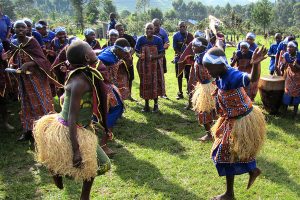


The densely forested, mist-covered hillsides of Bwindi Impenetrable National Park are home to roughly half of the world’s mountain gorillas. As they do not survive in captivity, the conservation of Bwindi is vital to their survival. This incredibly biologically diverse rainforest is over 25,000 years old, and aside from the gorillas it also provides shelter for several monkey species, baboons, chimps, elephants, antelopes and 350 species of birds. The park can be accessed from Buhoma in the north, and Nkuringo in the south. Both have an impressive array of luxury lodges, rustic bandas and budget campsites, as well as restaurants, craft stalls and guiding services. There are also plenty of opportunities to discover the local Bakiga and Batwa Pygmy cultures, through performances, workshops and fascinating village walks.
Size
321 sq km

- Gorilla Tracking: Habituated groups can be tracked in Buhoma, Nkuringo and Nshongi – permits ($500 per person) are limited and must be booked in advance form the Uganda Wildlife Authority.
- Guided forest walks: Immerse yourself in the Impenetrable Forest, with waterfalls, views of the Virunga Mountains and rivers, in a selection of three- to eight-hour trails.
- Birding: An impressive 350 species have been recorded in the park
- Primate viewing: L’Hoests, red tailed, blue and colobus monkeys are common in the Forest, as well as chimpanzees and baboons
- Village walks, music and dance performances and Batwa walks at Nkuringo, Nyundo, Buhoma and Rubuguri offer memorable experiences for culture lovers.

An estimated 320 mountain gorillas inhabit the forest, as well as several monkey species, chimpanzees, baboons, bushbucks and forest duikers (small antelopes).
Birding
Bwindi Impenetrable National Park offers some of the finest montane forest birding in Africa and is a key destination for any birder visiting Uganda. Amongst the numerous possibilities are no fewer than 23 of Uganda’s 24 Albertine Rift endemics, including spectacular, globally threatened species such as African Green Broadbill and Shelley’s Crimson wing. Common species include cuckoos, turacos, bee-eaters, flycatchers and shrikes – all easily viewable in a short walk along the main trail from Buhoma.

Getting Here: Roads in this region are extremely poor, especially during bad weather. The drive from Kampala via Mbarara takes six to eight hours, from Queen Elizabeth National Park two to three hours, and from Kabale in the south it is roughly two to three hours.
Climate: Bwindi ranges from around 1,160 to 2,600 meters altitude, and is consequently rather cold, especially at night. If possible, visitors should avoid the rainy months of April – May and September – November, though heavy rain can occur at any time.
Entrance fees:
Contact Uganda Wildife Authority (UWA) for more information about entrance fees and multi-day passes. Please notes that rates are subject to change.
Email: uwa@uwa.or.ug
Phone: +256 41 355-000
Web: www.ugandawildlife.org
UWA Tariffs 2020/ 2022: View here
Nearby Pearls
Contact us for more information about Pearls of Uganda
Email: info@pearlsofuganda.org